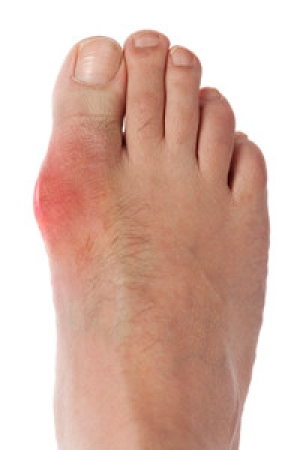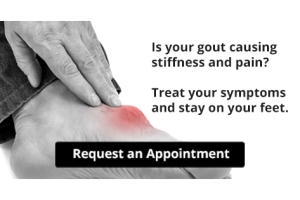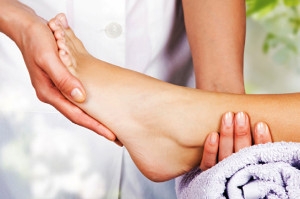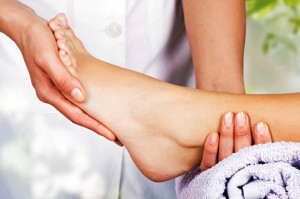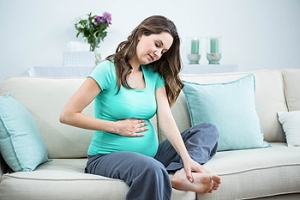Port Neches, TX (409) 727-1122

Elderly and their Feet
While proper foot care is important for everybody, senior citizens have the tendency to be more susceptible to certain foot conditions. The elderly should therefore be well informed about any problems that may arise and about what they can do to properly avoid or treat them.
Some of the most common foot problems seniors are susceptible to include foot ulcers, ingrown toenails, fallen arches, and fungal nails. A foot ulcer is an open sore on the foot and can be a result of diabetes and decreased sensation in the feet. An ingrown toenail is defined as when the nail grows into the side of the toe. Fallen arches are indicated by the instep of the foot collapsing. A fungal nails is a condition that results in deformed and discolored toenails.
In order to avoid these conditions it is recommended that the feet be inspected by the patient on a regular basis. If these inspections are carried out routinely, there is a good likelihood that problems can be identified before they become severe, or can even be avoided altogether. If any abnormality is discovered, it is important that the individual consult a podiatrist for diagnosis and information on treatment options.
Proper foot hygiene is also important. Making sure that you always have clean, dry socks on can be a major deterrent to many different problems including bacterial infections, foot odor, and certain types of fungus. Wet feet are a major cause of many of these problems. If your socks get wet, it is important to change them. Walking around in wet socks may not only lead to various infections, but can irritate the skin and result in a number of various complications. Clean, dry feet are less likely to be affected by fungal and other infections.
As people age, the fat present on your feet begins to deteriorate. The protective nature of this fat keeps the feet healthy by providing a barrier between your bones and the ground. This also aids in giving the skin on the feet a certain amount of elasticity. This is one factor that causes elderly people to develop some serious foot issues. Foot moisturizers can be helpful to avoid certain problems associated with this. However, water-based moisturizers do not work as well for elderly people as they do for the young. Instead, it is more effective to use an emollient instead. An emollient is effective because it binds the water in the foot, keeping it from becoming absorbed too readily which will result in dry skin. Emollients also have a special property called occlusion, which provides a layer of oil on the skin. This layer prevents the foot from drying up and can be very effective in treating dry skin disorders. If you can keep the skin on your feet healthy, this will substantially reduce the number of foot problems you will encounter in old age.
Proper footwear is another way to keep feet healthy. Shoes that fit well and provide proper support help prevent ingrown toenails and fallen arches.
Certain medical conditions such as diabetes or poor blood circulation increase the risk for foot issues. For individuals with any of these conditions it is extremely important to conduct regular foot inspections to make sure that there are no sores or infections present.
How Do I Treat My Sweaty Feet?
 People who experience plantar hyperhidrosis are often familiar with the embarrassment of having feet that sweat excessively. This can lead to an unpleasant foot odor in addition to leaving damp footprints while walking barefoot. Some patients find it beneficial to use an antiperspirant on their feet, and this may be helpful in reducing excess sweat. Research has indicated there may be positive results from using specific shoe inserts which may help to absorb sweat, in addition to sprinkling powder in the shoes. It may help to alternate wearing different pairs of shoes, and this can provide the opportunity to dry the shoes out after wearing them for the day. If you are afflicted with plantar hyperhidrosis, it is strongly advised that you consult with a podiatrist who can help you in determining the cause of this ailment, and suggest the proper treatment options.
People who experience plantar hyperhidrosis are often familiar with the embarrassment of having feet that sweat excessively. This can lead to an unpleasant foot odor in addition to leaving damp footprints while walking barefoot. Some patients find it beneficial to use an antiperspirant on their feet, and this may be helpful in reducing excess sweat. Research has indicated there may be positive results from using specific shoe inserts which may help to absorb sweat, in addition to sprinkling powder in the shoes. It may help to alternate wearing different pairs of shoes, and this can provide the opportunity to dry the shoes out after wearing them for the day. If you are afflicted with plantar hyperhidrosis, it is strongly advised that you consult with a podiatrist who can help you in determining the cause of this ailment, and suggest the proper treatment options.
If you are suffering from hyperhidrosis contact Pete O’Donald, DPM of Texas. Our doctor can provide the care you need to attend to all of your foot and ankle needs.
Hyperhidrosis of the Feet
Hyperhidrosis is a rare disorder that can cause people to have excessive sweating of their feet. This can usually occur all on its own without rigorous activity involved. People who suffer from hyperhidrosis may also experience sweaty palms.
Although it is said that sweating is a healthy process meant to cool down the body temperature and to maintain a proper internal temperature, hyperhidrosis may prove to be a huge hindrance on a person’s everyday life.
Plantar hyperhidrosis is considered to be the main form of hyperhidrosis. Secondary hyperhidrosis can refer to sweating that occurs in areas other than the feet or hands and armpits. Often this may be a sign of it being related to another medical condition such as menopause, hyperthyroidism and even Parkinson’s disease.
In order to alleviate this condition, it is important to see your doctor so that they may prescribe the necessary medications so that you can begin to live a normal life again. If this is left untreated, it is said that it will persist throughout an individual’s life.
A last resort approach would be surgery, but it is best to speak with your doctor to find out what may be the best treatment for you.
If you have any questions please feel free to contact our office located in Nederland, TX . We offer the newest diagnostic and treatment technologies for all your foot and ankle needs.
Hyperhidrosis of the Feet
Hyperhidrosis of the feet, also termed plantar hyperhidrosis, is characterized by excessive sweating of the feet that can be onset by any cause, such as exercise, fever, or anxiety. Most people suffering from hyperhidrosis of the feet also experience hyperhidrosis of the hands, or palmar hyperhidrosis. Approximately 1-2% of Americans suffer from this disorder.
Sweating is a healthy process utilized by the body in order to cool itself and maintain a proper internal temperature, which is controlled by the sympathetic nervous system. In individuals with hyperhidrosis, the sympathetic nervous system works in "overdrive", producing far more sweat than is actually needed.
Plantar hyperhidrosis is considered primary hyperhidrosis. Secondary hyperhidrosis refers to excessive sweating that occurs in an area other than the feet, hands, or armpits, and this indicates that is related to another medical condition, such as menopause, hyperthyroidism, or Parkinson's disease.
Symptoms of hyperhidrosis of the feet can include foot odor, athlete's foot, infections, and blisters. Because of the continual moisture, shoes and socks can rot which creates an additional foul odor and can ruin the material, requiring shoes and socks to be replaced frequently. In addition to the physical symptoms, emotional health is often affected as this disorder can be very embarrassing.
If left untreated, hyperhidrosis will usually persist throughout an individual's life. However, there are several treatment options available. A common first approach to treating hyperhidrosis of the feet is a topical ointment. Aluminum chloride, an ingredient found in antiperspirants, can be effective at treating hyperhidrosis if used in high concentration and applied to the foot daily. Some individuals can experience relief this way, while others encounter extreme irritation and are unable to use the product. Another procedure is the use of Botulinum Toxin A, commonly referred to as Botox. This is injected directly into the foot, and is effective at minimizing the sweat glands in the injected area. These injections must be repeated every 4 to 9 months.
If these treatments are ineffective, oral prescription medications may be taken in an effort to alleviate the symptoms. Again, some will experience relief while others do not. Going barefoot reportedly provides relief for most sufferers.
A final approach to combating hyperhidrosis of the feet is through surgery. Surgery has been less successful on patients with plantar hyperhidrosis than on those with palmar hyperhidrosis. It is only recommended when sweating is severe and other treatments have failed to work. This kind of surgery usually involves going into the central nervous system, and cutting nerves to stop the transmission of signals telling the foot to sweat.
Painful Gout and What May Cause It
 Patients who have experienced the medical condition that is referred to as gout are often aware of the severe pain and discomfort it may cause. It occurs as a result of genetic factors, or if foods are eaten in excess that have elevated levels of purines. This can cause crystals to form in the joints of the big toe, and it can often be debilitating. After a proper diagnosis is performed which consists of extracting a small amount of fluid from the affected joint, the correct treatment can begin. There are specific medications that provide relief from this condition. Additionally, research has indicated that it may be beneficial to incorporate healthy eating habits into your daily routine. These might include limiting red meats, shellfish, and cutting back on excess alcohol. If you think you have gout, it is advised that you seek the counsel of a podiatrist who can recommend the correct form of treatment.
Patients who have experienced the medical condition that is referred to as gout are often aware of the severe pain and discomfort it may cause. It occurs as a result of genetic factors, or if foods are eaten in excess that have elevated levels of purines. This can cause crystals to form in the joints of the big toe, and it can often be debilitating. After a proper diagnosis is performed which consists of extracting a small amount of fluid from the affected joint, the correct treatment can begin. There are specific medications that provide relief from this condition. Additionally, research has indicated that it may be beneficial to incorporate healthy eating habits into your daily routine. These might include limiting red meats, shellfish, and cutting back on excess alcohol. If you think you have gout, it is advised that you seek the counsel of a podiatrist who can recommend the correct form of treatment.
Gout is a foot condition that requires certain treatment and care. If you are seeking treatment, contact Pete O’Donald, DPM from Texas. Our doctor will treat your foot and ankle needs.
What Is Gout?
Gout is a type of arthritis caused by a buildup of uric acid in the bloodstream. It often develops in the foot, especially the big toe area, although it can manifest in other parts of the body as well. Gout can make walking and standing very painful and is especially common in diabetics and the obese.
People typically get gout because of a poor diet. Genetic predisposition is also a factor. The children of parents who have had gout frequently have a chance of developing it themselves.
Gout can easily be identified by redness and inflammation of the big toe and the surrounding areas of the foot. Other symptoms include extreme fatigue, joint pain, and running high fevers. Sometimes corticosteroid drugs can be prescribed to treat gout, but the best way to combat this disease is to get more exercise and eat a better diet.
If you have any questions please feel free to contact our office located in Nederland, TX . We offer the newest diagnostic and treatment technologies for all your foot and ankle needs.
Everything You Need to Know About Gout
Gout, typically found in diabetic patients, is an unusually painful form of arthritis caused by elevated levels of uric acid in the bloodstream. The condition typically strikes the big joint on the big toe. It has also been known to strike the knees, elbows, fingers, ankles and wrists—generally anywhere that has a functioning, moving joint.
The high level of uric acid in a person’s bloodstream creates the condition known as hyperuricema—the main cause of gout. Genetic predisposition occurs in nine out of ten sufferers. The children of parents who suffer gout will have a two in ten chance of developing the condition as well.
This form of arthritis, being particularly painful, is the leftover uric acid crystallizing in the blood stream. The crystallized uric acid then travels to the space between joints where they rub, causing friction when the patient moves. Symptoms include: pain, redness, swelling, and inflammation. Additional side effects may include fatigue and fever, although reports of these effects are very rare. Some patients have reported that pain may intensify when the temperature drops, such as when you sleep.
Most cases of gout are easily diagnosed by a podiatrist’s assessment of the various symptoms. Defined tests can also be performed. A blood test to detect elevated levels of uric acid is often used as well as an x-ray to diagnose visible and chronic gout.
Treatment for gout simply means eliminating symptoms. Non-steroid anti-inflammatory drugs or NSAIDs (Colchicine and other corticosteroid drugs, etc.) will quell the redness, the swelling, and the inflammation. However, managing your diet, lifestyle changes, and using preventative drugs are all helpful toward fully combating the most severe cases.
Those that lead an inactive lifestyle are at a higher risk for gout. Any amount of exercise decreases the probability of repeat encounters with the condition. Reducing your consumption of red meat, sea food, and fructose-sweetened drinks also reduces the likelihood of chronic gout as well.
Ingesting Vitamin C, coffee, and particular dairy products can help with maintaining a healthy lifestyle. There are new drugs out on the market that inhibit the body’s production of uric acid-producing enzymes. However, reducing or eliminating your overall levels of uric acid is the best remedy to ensuring you lead a gout-free life.
Foot Massages May Help to Reduce Anxiety
Foot massages have become increasingly popular, and research has indicated it may help to heal ailments in other parts of the body. When the toes are curled, and the portion of the foot is massaged under the ball of the foot, this may aid in reducing anxiety. Patients who are suffering from chronic pain in the body may find that rolling the sole of the foot on a tennis ball could bring mild relief. Lower back pain may be diminished when the pressure points in the arches are massaged, followed by firmly rubbing the entire sole of the foot. If you are diabetic, it is suggested that you seek the counsel of a podiatrist who can provide information about how nerves that are damaged can be affected by massaging.
Foot therapy is often necessary for those recovering from either foot deformities or foot injuries. If you have concerns regarding therapy, consult with Pete O’Donald, DPM from Texas. Our doctor can provide the care you need to keep you pain-free and on your feet.
Most Common Injuries
People who are active or athletes are prone to a variety of injuries. Therefore, it is often important to take part in physical therapy in order to quickly get back on the right track.
What to Do When Injured
Physical Therapy – This specialized treatment will focus on the affected area, speeding up recovery and the overall healing process. It is a proven method that has helped millions of people return from any injury.
During physical therapy you will undergo regimented training to get back into full form. Training is often very difficult, especially at first when the foot feels weak. Physical therapy often involves:
Basic stretching and twisting exercises – getting the feet’s mobility and flexibility up.
Massaging – the therapist will massage the injured area in order to activate the muscles and relax them.
Strengthening Exercises – this allows the muscles in the affected area to regain their full strength, a vital step towards full recovery.
If you have any questions please feel free to contact our office located in Nederland, TX . We offer the newest diagnostic tools and technology to treat your foot and ankle needs.
Foot Therapy for Sports Injuries
Whether in practice or in the game, athletes put their bodies through great stress. Some sports demand more from the body than others. However, every sport has an element of inorganic movement or unnatural motion. For example, in softball, a pitcher winds up and flings her body with an incredible amount of dexterity in order to get the most ideal velocity out of her pitches. This motion, incredibly taxing on the body, can cause serious injury.
One of the most common issues of athletic injuries happens in the feet. If it’s a damaging fracture that leaves the athlete sidelined or just a simple turf toe, foot injuries can still be very frustrating and painful. Regardless of the sport, athletes still require use of their feet in some fashion. This is why foot therapy is extremely vital for getting athletes back on the right track to return to the field.
No matter the injury, the best way to speed up the recovery period is to receive physical therapy. Physical therapy has proven to work for millions of people. Professional physical therapists are specifically trained to help people return to proper form from any injury.
During physical therapy, you will go through organized training in order to get back into form. Sometimes training can be quite difficult, especially in the beginning when there is more pain and the foot feels awkward. To alleviate this, you will do basic twisting and stretching exercises in order to get flexibility and foot mobility back up. The therapist will also massage the injured area to activate and relax muscles. Over time you will eventually move up to strengthening exercises, designed specifically so that the injured area is exercised.
Foot therapy for sports is a modern science miracle. Unlike other treatments that may employ the use of fancy chemicals and terminology, physical therapy is an evidence-based practice that offers the same benefits. Due to huge advancements in the knowledge of muscles and joints, doctors can turn catastrophic injuries around so that athletes can return to the game once more.
Foot Changes That Can Occur in Pregnancy
 There are numerous changes a woman’s body goes through while being pregnant. The feet are often affected, and obvious differences can be noticed. These can include swelling, chronic aching, and muscle cramps. It is helpful to buy shoes that fit correctly, and the best time to accomplish this is later in the day when the feet are at their largest. It is important to choose shoes that have adequate room for the toes to move freely in, as this can help to prevent unwanted foot conditions from developing. When the feet become swollen, many women find mild relief when the feet are elevated, in addition to performing gentle foot stretches. If you would like additional information on how to have your feet feel better during pregnancy, please consult with a podiatrist.
There are numerous changes a woman’s body goes through while being pregnant. The feet are often affected, and obvious differences can be noticed. These can include swelling, chronic aching, and muscle cramps. It is helpful to buy shoes that fit correctly, and the best time to accomplish this is later in the day when the feet are at their largest. It is important to choose shoes that have adequate room for the toes to move freely in, as this can help to prevent unwanted foot conditions from developing. When the feet become swollen, many women find mild relief when the feet are elevated, in addition to performing gentle foot stretches. If you would like additional information on how to have your feet feel better during pregnancy, please consult with a podiatrist.
Pregnant women with swollen feet can be treated with a variety of different methods that are readily available. For more information about other cures for swollen feet during pregnancy, consult with Pete O’Donald, DPM from Texas. Our doctor will attend to all of your foot and ankle needs.
What Foot Problems Can Arise During Pregnancy?
One problem that can occur is overpronation, which occurs when the arch of the foot flattens and tends to roll inward. This can cause pain and discomfort in your heels while you’re walking or even just standing up, trying to support your baby.
Another problem is edema, or swelling in the extremities. This often affects the feet during pregnancy but tends to occur in the later stages.
How Can I Keep My Feet Healthy During Pregnancy?
- Wearing orthotics can provide extra support for the feet and help distribute weight evenly
- Minimize the amount of time spent walking barefoot
- Wear shoes with good arch support
- Wear shoes that allow for good circulation to the feet
- Elevate feet if you experience swelling
- Massage your feet
- Get regular, light exercise, such as walking, to promote blood circulation to the feet
If you have any questions please feel free to contact our office located in Nederland, TX . We offer the newest diagnostic and treatment technologies for all your foot and ankle needs.
Foot Care for Pregnant Women
The natural weight that pregnant women gain causes their center of gravity to be completely altered. This causes them to have a new weight-bearing stance which adds pressure to the knees and feet. As a result, pregnant women often experience severe foot pain. The two most common foot issues experienced by women in their pregnancies are edema and over-pronation. It is important for all pregnant women to learn more about how to take care of their feet so they are more comfortable during their pregnancy.
Over-pronation, which is commonly referred to as flat feet, is caused when a person’s arch flattens out upon weight bearing. This causes the person’s feet to roll inward while walking. Pregnant women often experience this due to the sudden weight they gain.
Edema, also referred as swelling in the feet, typically occurs in the later part of the pregnancy. It is the result of the extra blood accumulated in the pregnant woman’s body. The enlarged uterus puts more pressure on the blood vessels in the pelvis which causes leg circulation to slow down. This causes blood to pool in the lower extremities.
Fortunately, there are ways to treat both edema and over-pronation. Edema can be treated by elevating the foot as often as possible. Wearing proper fitting footwear will also be helpful for those with edema. A treatment method for over-pronation could be orthotics. Orthotic inserts should be designed with appropriate arch support and medial rear foot for your foot.
It is best for pregnant women to buy new shoes during the day, because this is the time where swelling is at its peak. Pregnant women also shouldn’t rush when buying shoes. It is always advised that you make sure your shoes fit properly but this is especially important during pregnancy.
If you are a pregnant woman, you should consult with a podiatrist in order to make sure your feet are healthy throughout the entirety of your pregnancy.



